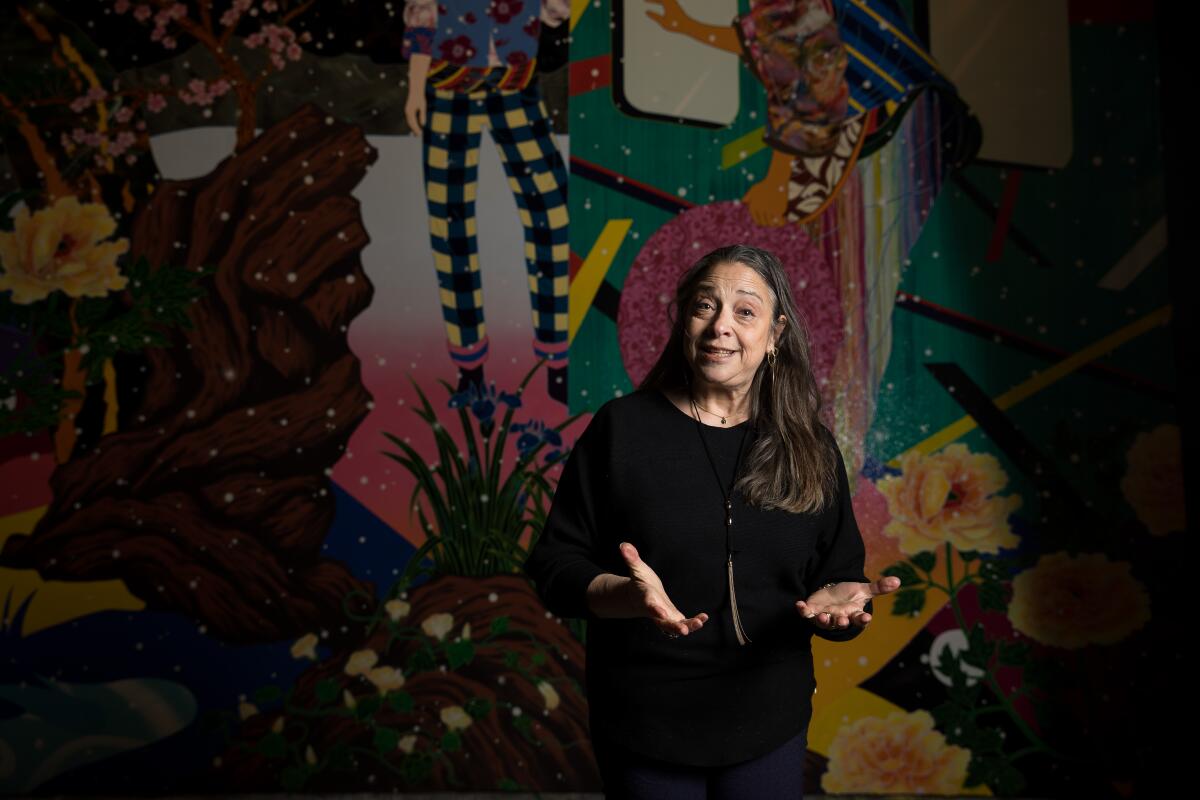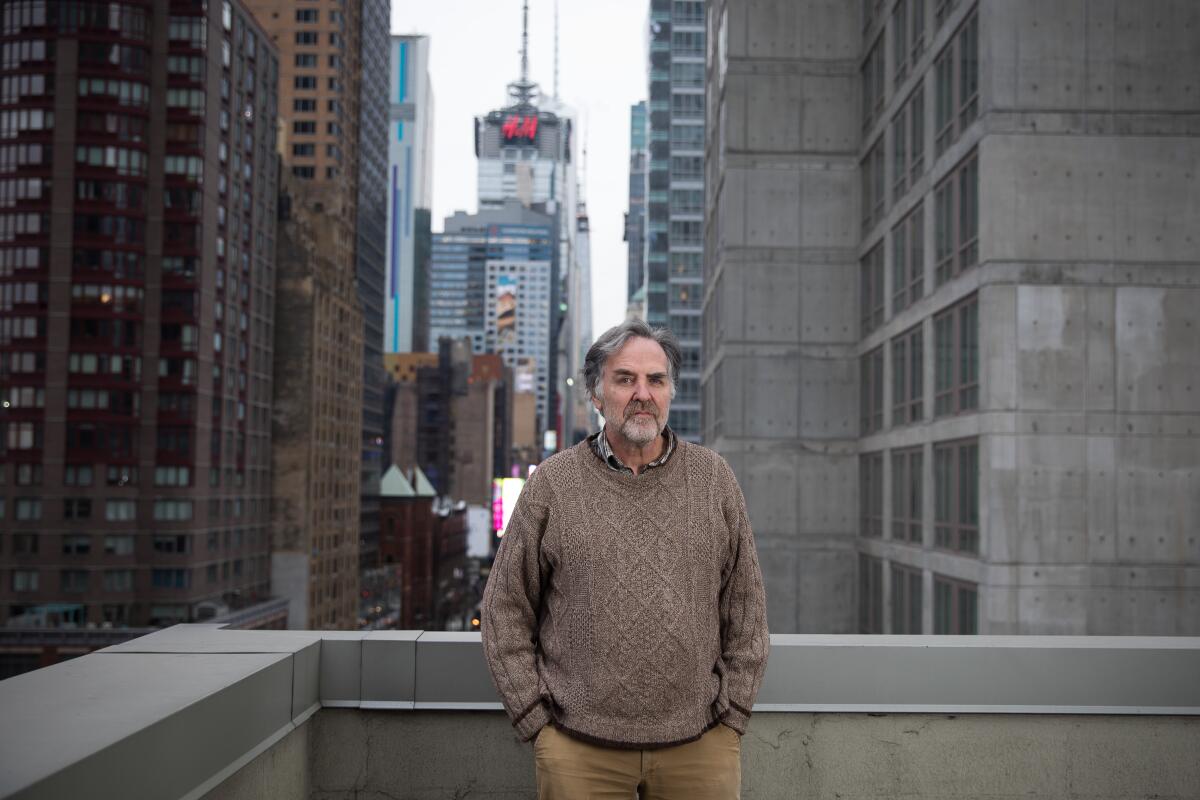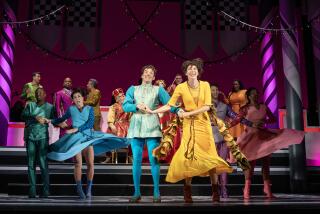What the Foundry’s Melanie Joseph and Playwrights Horizons’ Tim Sanford mean to theater

- Share via
NEW YORK — It’s impossible to imagine off-Broadway in the last quarter century without the contributions of the Foundry Theatre’s Melanie Joseph and Playwrights Horizons’ Tim Sanford. The long-term artistic stewards of these organizations have decided to move on after immeasurably enriching our contemporary theater with their visionary leadership.
The Foundry, which the Canadian-born Joseph closed this year, launched Rinde Eckert’s “And God Created Great Whales” and Tarell Alvin McCraney’s “The Brothers Size,” along with genre-defying works by David Hancock, Carl Hancock Rux and David Greenspan. The company’s annual Free Range Thanksgiving plays included Heidi Schreck’s first stab at “What the Constitution Means to Me.” During Sanford’s tenure as artistic director, Playwrights Horizons presented three plays that went on to win the Pulitzer Prize: Annie Baker’s “The Flick,” Bruce Norris’ “Clybourne Park” and Doug Wright’s “I Am My Own Wife.”
But this is only a portion of the legacies Joseph and Sanford leave behind as they contemplate their next acts. Founded by Joseph in 1994, the Foundry, which produced artistic offerings, community programs and activist conferences on issues ranging from genocide to economic inequality, created a model that proved a theater company could examine its relationship to the world while upholding the most rigorous aesthetic standards. Playwrights Horizons has been quite simply the most important crucible for contemporary playwriting in America.
In November I had breakfast with Joseph at her Chelsea apartment, then jumped on the subway to meet Sanford at his West 42nd Street theater. I’ve known them both from my days at the Village Voice and as a judge on the Obie Awards but have stayed in touch only through the work that has regularly drawn me back to New York, in those fugitive moments away from the Broadway hubbub.
My mission was simple: To flush out the secrets of their artistic flourishing and to come away with a better understanding of what it takes to lead a theater with conviction, integrity and impeccable taste. The Foundry, which never had a permanent building, and Playwrights Horizons, which operates out of a sleek two-stage complex, aren’t comparable organizations. But Joseph and Sanford have something in common: a discerning eye for path-breaking talent and rare gift for incubating it.
Joseph, who greeted me with a warm hug, beaming in her mother-earth-neo-Marxist way, announced the end of her company in a characteristic manner. She sent out invitations to a party, “a very merry un-birthday party, a closing night party, an opening night party, an Irish wake, dance-till-you drop bacchanal — to give the Foundry Theatre a kiss goodbye.”
The event was also a book launch for “A Moment on the Clock of the World,” the values-clarifying anthology edited by Joseph and David Bruin that features essays by intellectuals, critics, producers and artists with a deep intimacy with this revolutionary company. Cornel West, one of the founding board members, elucidates in his foreword the spiritual framework that set the Foundry apart throughout its 25 years. Critic Alisa Solomon, in an essay of magnificent witness-bearing, illuminates the “querying artistic spirit” of the Foundry’s body of work, which demanded “an extraordinary measure of critical complicity” from spectators while testing the line between art and the world surrounding it.
From the company’s first production, “The Convention of Cartography,” Hancock’s brilliant faux art exhibition show, Joseph created an air of intrigue around the Foundry’s offerings. The invitation to audiences was seen as less a marketing tool than a theatrical gambit — a prelude of the active engagement theatergoers had in store for themselves.
“I knew from the beginning I was never going to do a season,” Joseph said as we dug into the scrumptious frittata she prepared. “I also knew that I always liked the idea of inviting people to a special event. The circus is coming to town. Whether it was a dialogue, a show or a community dinner.”
The Foundry was in a continual quest to discover its purpose, but it was guided by precepts. First and foremost, Joseph wanted to create work that wasn’t available elsewhere. She provided artists with a space in which they could dream in ways not permissible in more orthodox settings. Work that told you “what you already think you know” was for other theaters. She wanted experiential novelty, as exemplified in “The Provenance of Beauty,” the theatrical bus tour through the South Bronx she devised with poet Claudia Rankine that gave voice to the borough itself.
Without having to program in a traditional way, Joseph could allow artists to take the time they needed, even if that meant larger than usual gaps between productions. Touring extended the Foundry’s visibility. And social justice offerings, such as “A Conversation on Hope,” “This Changes Everything” (a dialogue on climate justice) or the “Money Talks” series, were integral to the identity of a company that was itself a work of art, a living embodiment of creative vision.
First and foremost, Melanie Joseph wanted to create work that wasn’t available elsewhere.
Joseph recognized that the management of the theater had to reflect its artistic philosophy. She developed the Foundry as “an organism rather than an organization,” experimenting with shared leaderships structures and resisting the celebrity fundraisers favored by high-powered boards of directors.
“For a little radical company like mine to have a money board was pretty impossible,” she said. “You need people who know people who have money, and none of my people ever knew people who had money.”
So how did the Foundry survive for 25 years? Joseph mulled the question while making another pot of coffee.
“We didn’t do more than we could,” she said. “We hit foundations hard because they don’t exist if we don’t exist. Their mission is to give money away, and I took it and used it better than they ever imagined. I never had a deficit in 25 years. I would walk with a sandwich board proclaiming that success, because it meant I never owed anybody money. The people I worked with needed that money. How could I not pay an artist?”
For the last several years, the Foundry practiced unusual transparency by publishing budgets for shows in the programs. Joseph is especially proud that most of the money went to people rather than to mortgages or marketing campaigns. And it’s this fierce concern for the material lives of creative workers that guided her decision-making. She acknowledged that she’d never have been able to create the Foundry if it weren’t for her rent-stabilized apartment. She believes that talking about bills, health insurance and housing is necessary if artists are to be truthful in their representations of the world.
In resisting the capitalist imperative to grow, the Foundry opted to deepen. Could the company have done more? Probably yes, she said, but at what cost? Although she recently turned 64 and shows no signs of slowing down, she decided to close the Foundry in part because the intersectional model she created of art, dialogues and community engagement has been more widely adopted by other theaters.
She also hinted at a certain weariness of the “nonprofit industrial complex.” Jumping through the hoops of grant applications could weary anyone. But more than anything, her intuition told her it was time. Her focus now is on developing a new work with Brazilian director Renato Rocha that’s coming to the Brooklyn Academy of Music as well as a number of her own writing projects.
The recent outpouring of love and appreciation from the off-Broadway community has touched her deeply, but she confessed that it often felt lonely carving an independent path. She wasn’t complaining, merely being honest about the realities. When I told her that she pulled off the near impossible, she wiped away a tear and said, “Yes.”
“Theaters’ legacies are often who are the artists that they’ve unleashed on the world or what are the fabulous plays, but for me that is only part of what our legacy is,” she said. “You began by asking how the hell did we do this? I think that’s the Foundry’s legacy. That you can.”

Playwrights Horizons has been quite simply the most important crucible for contemporary playwriting in America.
Sanford, 66, has been working at Playwrights Horizons since 1984. He began in the literary department and became artistic director in 1996. An amiably crusty man with an ironic half-smile, he ushered me into his office, an unpretentious hive littered with scripts, books and papers.
He was in good spirits, happily sharing the news of his recent marriage to Aimée Hayes, the producing artistic director of New Orleans’ Southern Rep Theatre. That, he said, played a role in his thinking about the future. Adam Greenfield, who like Sanford started in the theater’s literary office, has been appointed his successor and will assume the role in July. Sanford will be around for Playwrights Horizons’ upcoming 50th-anniversary season, taking on the title of outgoing artistic director through June 2021.
Running a theater as vital as Playwrights Horizons doesn’t leave time for much else. Sanford has a long wish list of projects. He took down from his shelf a bound copy of his PhD dissertation from Stanford, where he studied dramatic literature, and shared that he wanted to translate the manuscript from “academese into English.”
He also wants to publish a volume of the invaluable interviews he’s done over the years with the illustrious roster of playwrights produced at the theater. And he’d like to return to directing, a prospect he knows won’t be easy as someone who has been hiring directors to work at Playwrights Horizons.
“In this environment, we don’t really take care of our elders,” he said. “I’m thinking of starting a theater company that supports the work of artists over the age of 60.”
Sanford’s readiness to respond to gaps in the theatrical landscape has been integral to Playwrights Horizons’ success. In response to the book “Outrageous Fortune: The Life and Times of the New American Play,” Todd London, Ben Pesner and Zannie Giraud Voss’ 2009 study of the economic hardships confronting our playwrights, Sanford instituted a program that provided health insurance for a year to any writer with a production at his theater.
Another change he ushered in was paying playwrights for audition and rehearsal time. “They’re expected to be there, but they don’t get money until royalties start. It was a manageable amount of money for us, and we even got a New York Times article about it. That felt good. But I think we erred in doing this on our own rather than having a meeting and cajoling all the artistic directors into adopting it. Ultimately, it was self-serving of us, because you’re always looking to distinguish yourself, but the motivation was to honor the writer.”
The playwright has always come first at Playwrights Horizons, but does the theater have a sensibility today? Certainly, the old taunt (Gay Whites Horizons) no longer resounds now that the programming has become more widely inclusive. Sanford turned to Proust to explain his artistic philosophy.
“In his magnificent final book, when he’s analyzing style, he writes that there are as many original styles as there are original writers,” Sanford said. “Our job as producers and theater makers is to honor what’s unique in a play.”
Borrowing a distinction made by playwright Richard Nelson when he was director of Yale’s MFA playwriting program, Sanford said he was less interesting in fixing a play than in solving it: “No one looks at Shakespeare’s problem plays and says how should we fix this. There are some interesting problematic scenes, but maybe they’re on purpose. Let’s figure out how they’re supposed to happen.”
That said, he made clear that he doesn’t do plays that can’t benefit from the theater’s long preview periods. “The assumption is that every play, whether it’s a world premiere or New York premiere, still has work to do.”
How much can a play evolve during the preview period? Sanford recounted a Craig Lucas play in which the author had a revelation that had an actor later recounting, “Oh, that was the week when my character completely changed.”
Sanford has faith that Greenfield will uphold traditions, but he’s well aware that the economics of institutional theater isn’t getting easier. “We all know the subscription model is waning,” he said. “I would say the pace of deterioration over the last two to three years has been accelerating.”
Yes, the ground is shifting beneath even those theaters that seem to be doing everything right.
“The knock on subscribers is that they haven’t chosen to see a particular play, unlike single-ticket buyers, who have sought it out and are going to be more engaged by it. I don’t think that’s true. But our focus has been on memberships and loyalty initiatives, and the one that is the most successful is for those who are 35 and under. It’s free to sign up and then, if you want to come to a play, it’s $25. If you bring a friend, it’s $35. That’s what we have to do to make sure young people are still coming.”
Sanford’s fundamental philosophy is that you get the audience you deserve. “If I want an adventurous audience, then I have to give them adventurous plays,” he said. He pointed to his 1997-98 season as a turning point. “I saw that this was a theater that can embrace something as wild and satirically on edge as Christopher Durang’s ‘Betty’s Summer Vacation’ and something as steeped in delicate realism as Nelson’s ‘Goodnight Children Everywhere.’ To me, that’s what a writer’s theater means.”
Acutely cognizant of the ecology of New York theater, Sanford acknowledged a hearty appetite for downtown work.
“I’m always looking for the play that is going to allow the writer to cross 14th Street and come up to Playwrights Horizons. I wanted to produce Clare Barron’s ‘Dance Nation,’ but it’s edgy, so it pushed my audience. But it also opened a door. Because these writers are not going to be able to make a career until they get more than the meager royalties they might earn for a show downtown.”
Once considered laggard in the area of diversity, Playwrights Horizons has increasingly been leading the charge.
“When I’ve been asked, ‘Why do you have such a good track record with female writers?’ my response, rather than going after my colleagues, was that our specialty has always been new plays. And the training programs have gotten better in making sure they had equal representation. That has extended to writers of color as well, so there are fewer excuses for not having diverse seasons, because there are more writers to choose from.”
Like Joseph, Sanford combines optimism with realism, imagination with practicality. Passion for artistic freedom is ballasted by a concern for the economic welfare of artists. Whatever excitement the future holds for the American theater, it’s thanks to artistic leaders likes these whose ethics have been as forward-thinking as their aesthetics.
More to Read
The biggest entertainment stories
Get our big stories about Hollywood, film, television, music, arts, culture and more right in your inbox as soon as they publish.
You may occasionally receive promotional content from the Los Angeles Times.










